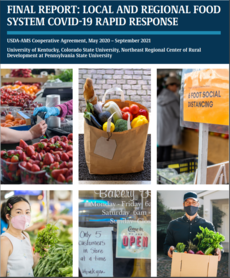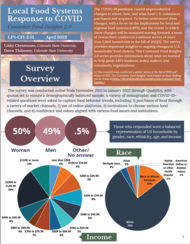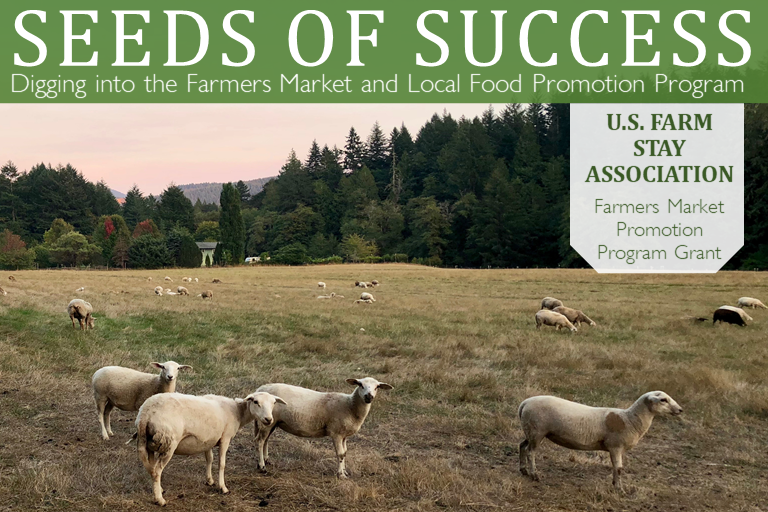|
Farmers Market and Local Food Promotion Program (FMLFPP) & Regional Food System Partnerships (RFSP) - Applications due May 16
In fiscal year 2022, the Local Agriculture Market Program (LAMP) will receive a total of $97 million in competitive grant funding to help local and regional food entities develop, coordinate and expand producer-to-consumer marketing, local and regional food markets and local food enterprises. The total includes $65 million of supplemental American Rescue Plan (ARP) funding and $32 million in funds provided through the 2018 Farm Bill. This ARP funding will promote competition and create more and better markets for local and regional food producers by expanding and strengthening opportunities to sell to institutions, such as universities, hospitals, and settings operated by local, tribal, and state governments. Of the $97 million, LAMP’s Farmers Market and Local Food Promotion Program (FMLFPP) will receive $57 million and the Regional Food System Partnerships (RFSP) will receive $40 million. Applications must be submitted electronically through www.grants.gov by Monday, May 16, 2022, at 11:59 p.m. Eastern Time.
The Acer Access and Development Program (Acer) and the Federal-State Marketing Improvement Program (FSMIP) - Applications due April 26
On February 16, 2022, AMS announced $7 million in competitive grant funding for the Acer Access and Development Program (Acer) and the Federal-State Marketing Improvement Program (FSMIP).
The Acer Program supports the efforts of states, tribal governments, and research institutions to promote the domestic maple syrup industry. Acer supports two types of projects: (1) Market Development and Promotion projects to improve consumer knowledge, awareness and understanding of the maple syrup industry and its products and (2) Producer and Landowner Education projects to advance producer knowledge, awareness and understanding of research, educational resources, or natural resource sustainability practices affecting the maple syrup industry and its products.
FSMIP offers grants to assist in exploring new market opportunities for U.S. food and agricultural products, and to encourage research and innovation aimed at improving the efficiency and performance of the marketing system. FSMIP grants require a one-to-one dollar match.
For more information about grant eligibility and previously funded projects, visit the Acer and FSMIP web pages. Applications must be submitted electronically through www.grants.gov by 11:59 p.m. Eastern Time on April 26, 2022.
Call for Grant Program Peer Reviewers
AMS is seeking subject matter experts to evaluate applications for the Farmers Market Promotion Program (FMPP), Local Foods Promotion Program, (LFPP), and Regional Food System Partnerships Program (RFSP). Reviewers receive training on the respective programs. Reviewing applications takes approximately 4-5 weeks. Reviewers evaluate applications assigned to them independently, then come together with other panel members virtually to discuss their findings and finalize reviews and scoring. Non-federal reviewers will be compensated for their time.

The COVID-19 pandemic prompted AMS to convene a project team to examine COVID-19 impacts to local food systems across the U.S. The report finds that local and regional food systems demonstrated an ability to quickly adapt to changing conditions, for example adopting new delivery/payment methods for contactless delivery or establishing new systems for reservations and ordering to ensure social distancing, associated with the COVID-19 pandemic – especially in comparison to national/global supply chains. However, the impact of COVID-19 on local food sectors varied tremendously.
This report outlines project outputs along with key insights and ideas for future research.
|
Consumer Survey

The Local and Regional Food Systems (LRFS) COVID Recovery and Resilience Project conducted a second nationwide survey of 5,000 households in the fall of 2021 to better understand the changes in where, how, and what food U.S. consumers purchase and acquire. The survey focuses on the implications for LRFS, and the extent to which changes stemming from the COVID pandemic will be sustained moving forward. The team will be publishing a series of Consumer Food Insights exploring changes in consumer food behavior.
|
Webinars
The recordings and webinar summaries for the March Webinar, The Local Food Environment: Data sharing across local food networks and the April Webinar, Tracking Consumer and Market Trends are now available.
Going Far by Going Together Webinar – May 13
Join us for the May Webinar, Going Far by Going Together: Building a network of food system networks. LRFS rely on an array of philanthropic, state, and federal funding sources to support efforts to strengthen and expand regional markets. As a part of the application process, stakeholders are asked to identify, measure, and report outcome indicators and report those on a regular basis to the awarding agency. Despite thoughtful development, measurement, monitoring and reporting by awardees, these data are not readily accessible. Therein lies great and untapped potential to advance the state of LRFS data and metrics. Recognizing the limited value of the indicators in their current state, food system stakeholders would benefit from improved access to this information. Join us for a panel discussion with a LRFS network coordinator, funder, and evaluator as we imagine a future where grant project evaluation and reporting was used to better align and allocate resources to LRFS, and by LRFS stakeholders to help understand the lay of the LRFS landscape and future program development efforts.
USDA’s National Agricultural Statistics Service (NASS) will release the 2020 Local Food Marketing Practices data on April 28, at 3:00pm ET. The data will be published in the NASS Quick Stats database at quickstats.nass.usda.gov.
The Agriculture and Food Research Initiative - Education and Workforce Development (EWD) focuses on developing the next generation of research, education, and extension professionals in the food and agricultural sciences. In 2022, the National Institute of Food and Agriculture (NIFA) requests applications for the AFRI’s Education and Workforce Development program areas to support:
- professional development opportunities for K-14 educational professionals;
- non-formal education that cultivates food and agricultural interest in youth;
- workforce training at community, junior, and technical colleges;
- training of undergraduate students in research and extension;
- fellowships for predoctoral candidates and postdoctoral scholars; and
- special workforce development topics.
Each month, we’re highlighting the work of Farmers Market and Local Food Promotion grant recipients.
 U.S. Farm Stay Association
U.S. Farm Stay Association is a non-profit 501 (C) 6 trade association that provides information on authentic farm and ranch stay vacations. Throughout the U.S., farm stays provide people with the opportunity to learn more about farm life and local food. Unfortunately, the farm stay is a concept that not many people know about or know how to find. Farm stays can benefit farms through revenue diversification and increased public awareness of local and regional foods. In 2017, the U.S. Farm Stay Association received a Farmers Market Promotion Program (FMPP) grant to provide training and technical assistance for new and existing farm stay operators, partner with farmers markets in Oregon for promotion, and update a website with farm stay opportunities.
 USDA Under Secretary for Marketing and Regulatory Programs Jenny Lester Moffitt and other USDA leaders frequently meet with grantees and stakeholders when they travel around the country. Stay up to date about their travels and learn more about how USDA’s grants, technical assistance and research supports local and regional food systems when you follow along on Twitter, Instagram and LinkedIn.
|